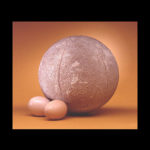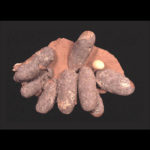Until recently, paleontologists have used dinosaur bones, skeletons, footprints, and trackways to study these extinct creatures, which continue to fascinate children and adults alike.
Now, new discoveries of fossil dinosaur eggs, nests, and even embryos are providing a new avenue of investigation for scientists who seek not only information on biological relationships, but also on the behavior of these animals, and are shedding new light on intriguing questions paleontologists have been pondering for over a century.
- Were baby dinosaurs cute?
- Were dinosaurs social animals?
- Did dinosaur adults stay near their nests and care for their emerging hatchlings?
- Did adult dinosaurs care for their young beyond infancy?
- To which group of modern-day animals are dinosaurs most closely related?
- Did at least some dinosaurs have feathers?
- Are birds the modern descendants of dinosaurs?
- Can the study of eggs, nests, and babies add to our knowledge of dinosaur extinction?
The answer to the first question is a matter of opinion; visitors can come and see for themselves. The answers to the other questions are a matter of scientific debate; the exhibit presents some of the evidence for these ideas, and visitors are invited to form their own opinion.
The science of dinosaur eggs and embryos is still relatively new. Compared to bones, dinosaur eggs are much less frequently found and more difficult to study.
Dinosaur eggs are known from all continents except Australia and Antarctica. In recent years, egg finds in Montana and China, primarily of Late Cretaceous Age (100 million to 65 million years ago) have increased dramatically the number of eggs known. Whether dinosaur embryos are preserved within those fossil eggshells, and whether the bones can be successfully exposed and studied, are difficulties that paleontologists face.
- 75-Million-Year-Old Sauropod Egg, From Patagonia, in Argentina
- Nest of Oviraptor Eggs
- “Baby Louie,” Model of oviraptor dinosaur egg and embryo by Brian Cooley. Photograph by Louie Psihoyos.
- Two of the Largest Known Dinosaur Eggs, From a site in the Xixia Basin, China
CLASSIFICATION OF EGGSHELL
Scientists classify eggs of different animals according to size and shape of the egg, thickness and texture of the eggshell, and according to the biocrystalline structure of the eggshell. This is determined by examining thin sections of eggshell under a microscope with polarized light and a scanning electron microscope for more detail. Broad similarities and differences in structure have permitted scientists to group eggshell into six basic types and a number of subtypes.
The six major types of eggshell include:
- Turtle: testudoid
- Gecko: geckoid
- Crocodile: crocodiloid
- Bird: ornithoid
- Two types of dinosaur eggshell
- Dinosauroid-spherulitic
- Dinosauroid-prismatic
DINOSAUR EGGS
Based on the characteristics noted above, dinosaur eggs are divided into several groups, which are believed to correspond to major groups of dinosaurs:
- Sauropods: large quadrupedal herbivores (four-footed vegetarians), such asApatosaurus
- Theropods: bipedal carnivorous dinosaurs (two-footed meat eaters), such as oviraptors
- Ornithopods: bipedal herbivores (two-footed vegetarians), such as hadrosaurs (duck-billed dinosaurs)
Ornithopod eggs and sauropod eggs show dinosauroid-spherulitic structure, while some theropods show dinosauroid-prismatic structure. Interestingly, some theropod eggs have ornithoid shell structure, the same type as birds. The subtype of these eggshells is the same as that of the modern large, flightless birds, such as the ostrich, emu, and cassowary. This is perhaps more evidence in favor of the now widely held view that birds are descended from one group of dinosaurs.
DINOSAUR EMBRYOS
In answer to the question, “Are there embryos still inside dinosaur eggs?” the answer is yes, but rarely. A slow, painstaking method of acid etching developed by paleotechnician Terry Manning of Leicester, England, has exposed embryonic bones in a few Late Cretaceous (ca. 65 million years ago) eggs from China. Preparator Amy Davidson of the American Museum of Natural History has also exposed dinosaur embryos from Mongolia. Sauropod embryos are also known from Patagonia, Argentina. Embryo skeletons are small and fragile, and contain more cartilage than adult skeletons, making preservation less likely.
While embryo skeletons provide the strongest link of eggs to individual species of dinosaurs, problems can occur in their identification. Bones may not be articulated (in the place they would be in life), and the young may not show the same identifying characteristics as adults. Also, as in the case of Baby Louie (a hatchling), an adult skeleton from the same area may not even be known yet, making an exact comparison of young to adult impossible.
So how do we know what dinosaurs laid which eggs? The most exact determination comes from studying embryos or hatchlings found in nests or by finding adult skeletons in nests with eggs. Both of these instances are relatively rare. Broad groups of dinosaurs can be identified by the macro characteristics of eggs (size, shape, thickness, texture) and the microscopic structure of the eggshell. And educated guesses can be made by finding adult bones in the same geologic layer and locality as the eggs.
THE EXHIBITION
The exhibition Hatching the Past: Dinosaur Eggs, focuses on the beginnings of dinosaur life. It includes real examples of the different types of dinosaur eggs, along with artists’ drawings, beautifully detailed models, and photographs of finds in the field.
In the exhibit, twenty real dinosaur eggs and three nests with more than forty eggs are displayed. Fossils from France, Argentina, China, and Mongolia are exhibited, most dating to the Cretaceous period (65–145 million years ago).
This assortment of real eggs and nests is enhanced by an assortment of cast eggs and nests from around the world, other casts and models, photographs, a video, holographic images, and striking lifelike models and artwork of embryos and hatchlings to illustrate their appearance, help us to visualize the beginnings of life for some of the most formidable animals that ever lived, and provide the latest findings of leading dinosaur experts.
The models, by nationally known dinosaur artists, are of embryos and hatchlings, and feature the latest interpretations of paleontologists as to the appearance of the young creatures. With evidence mounting year by year for the idea that birds are descended from some dinosaurs, one model, appropriately called a “chick,” advances this view.
DINOSAUR NESTS
Three authentic nests, two with eight eggs each and one with twenty-six eggs, are included in the exhibit.
Nests of eggs can tell scientists the number and arrangement of eggs. Clusters of nests have been discovered in a few locations. Nests and nest clusters can provide clues to dinosaur behavior:
- Were nests covered?
- Did adults care for their young?
- Did some dinosaurs nest together in colonies for better protection of the young?
“BABY LOUIE”
One section of the exhibit focuses on “Baby Louie,” the first articulated (bones still in the proper place) theropod dinosaur hatchling ever found. Exposed by Colorado amateur paleontologist Charlie Magovern from a block containing four dinosaur eggs from China, the tiny skeleton was dubbed “Baby Louie” after photographer Louie Psihoyos, who photographed it for a feature story inNational Geographic magazine. The original egg block is still being studied, but a cast of it is included in the exhibit, along with the original model of the therizinosaur embryo, “Baby Louie,” sculpted by artist Brian Cooley for the cover of the May 1996 National Geographic magazine.
However, more recent work on the bones has suggested a different interpretation of the baby dinosaur’s appearance—this one with feathers! A model of this “chick” is also included in the exhibit. Also available in the gallery is a short video presentation by paleontologist Robert Bakker on the “Baby Louie” project.
TENNESSEE CONNECTION
The McClung Museum has the only dinosaur bones found so far in the State of Tennessee—five bones of the hadrosaur (duck-billed dinosaur) Edmontosaurus—which are maintained in the museum’s Geology and Fossils of Tennessee exhibit. Relevant to those fossil hadrosaur bones from Tennessee, Hatching the Past: Dinosaur Eggs includes a real hadrosaur nest and eggs from China.
Hatching the Past presents another line of evidence in the study of those fascinating extinct creatures, the dinosaurs. It also underscores the continuing search for fossils and the ways in which new evidence can add to or alter our interpretation of life in the very distant past.




